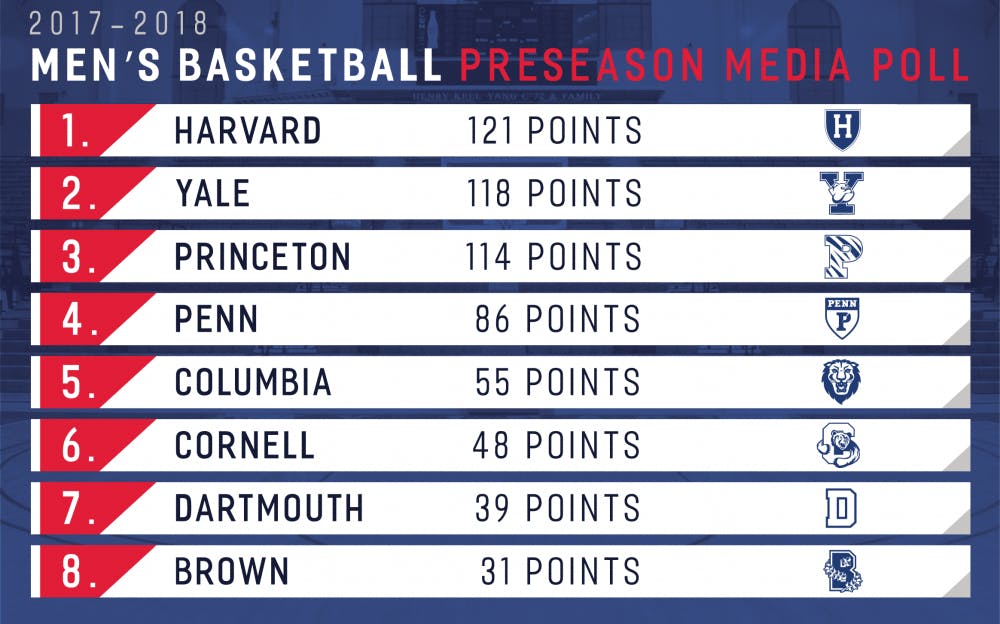
Harvard, Yale, Princeton, and Penn men's basketball are all predicted to return to the Ivy League Tournament for a second straight year.
Credit: Zach SheldonPenn men’s basketball is going to improve this year.
All but one player who touched the floor last season for the Red and Blue will be returning in 2017-18. That doesn’t even account for the return of junior guard Antonio Woods. Throw in another talented class of newcomers, and all the ingredients are there for a deeper and better Penn personnel.
Unfortunately for the Red and Blue, everybody else is getting better too.
Yale returns five of its top seven scorers from last season, and that doesn’t even include the comeback of senior star Makai Mason. Harvard returns eight of its top ten scorers, including reigning Ivy Rookie of the Year Bryce Aiken. Even defending champion Princeton, which saw two first team All-Ivies graduate, returns a deadly trio of guards in Amir Bell, Devin Cannady and Myles Stephens.
Some have argued that “it’s the top three, then everyone else.” In its annual rankings of all 351 D-I NCAA basketball programs, ESPN listed Princeton at 76th, Yale at 80th, Harvard at 85th, and Penn at 129th. However, those rankings do not put much weight on the Quakers' late-season turnaround, suggesting that the gap is not that wide.
Whether one sees Penn as the little brother to the Harvard-Yale-Princeton triumvirate or not, though, one thing is undeniable — the Ivy League is improving, and fast.
“Ten or 15 years ago, we had two teams [Penn and Princeton] that were really good, and a lot of mediocre teams,” 19th-year Yale coach James Jones said. “Now we have quality teams up and down the league, especially at that top four, that are really good.”
The conference’s ascent is by no means just beginning. This decade, the Ivy League has won five NCAA Tournament games — in contrast, the entire Ancient Eight didn’t get one March Madness win in the 2000s. According to Jerry Palm’s Conference RPI, the league has finished in the top 15 conferences in three of the past seven seasons after doing so only once from 1995 to 2010.
So what’s led to the drastic change? For starters, the Ivy League schools have revamped their financial aid policies greatly. Harvard served as a pioneer in 2006, when it made admission free for students whose families made under $60,000 annually.
The other Ivies soon followed suit with similar policies, and as Penn coach Steve Donahue admitted, “The financial aid is a big part [in our ability to increase our pool of talented players] … Unlike most sports in the Ivy League, we’re going against [teams whose players are on] full scholarships.”
But while financial aid can help one’s admission hopes, it can’t fuel a personal desire to give up major conference glory. What goes on off the court has always been the Ivy League’s distinguishing factor — and when that academic prestige gets combined with a rise in nationwide respect on the floor, plus more television exposure with the Ivy tournament, it’s a recipe difficult for recruits to pass on.
“I think student-athletes are really starting to see what the Ivy League has to offer, in terms of not just athletics, but the history of the academics and the great culture around the universities,” said Penn forward AJ Brodeur, who held scholarship offers from Boston College, Notre Dame and Saint Joseph’s, among others. “It’s great for the league, and I think that upward trend will only continue.”
Brodeur’s optimism is more than justified. Harvard made some major headlines with its Class of 2016, which ended up ranked 10th in ESPN’s recruiting rankings, and it’s beginning to look like the Crimson was more the rule than the exception.

Princeton raised eyebrows when it got a commitment from Jaelin Llewellyn, the nation’s 16th-ranked point guard in the Class of 2018. Harvard picked up a commitment from fellow Class of 2018 top-100 player Spencer Freedman.
Keeping up with the arms race, Penn’s Class of 2017 features players with offers from Temple (Jelani Williams), Dayton (Eddie Scott), and Pittsburgh (Jarrod Simmons), showing that the firepower joining the Ancient Eight will only continue rising.
As impressive as the headlines and recruiting rankings are, a couple of statistics still show that there is indeed room for improvement across the Ancient Eight.
The conference has still never seen two teams make the NCAA Tournament on the men’s side. At the professional level, Jeremy Lin remains the only Ivy alumnus in the NBA.
But if the league’s trajectory continues on its current path, these stats will turn into fiction before the country knows it.
“[Two-bid Ivy] is the one thing that I’ve been hearing about, and that should be the goal for the whole league,” Brodeur said. “I definitely think within the next five years, that’s a real possibility.”
“You will see kids in this league, in the next five to ten years, in the NBA,” Donahue said. “It’s just too good of talent coming in.”
The Daily Pennsylvanian is an independent, student-run newspaper. Please consider making a donation to support the coverage that shapes the University. Your generosity ensures a future of strong journalism at Penn.
Donate






